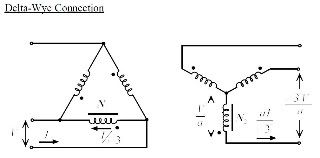This is 3 phase problem. If there is a transformer with the high side (15KV) delta and low side (6.6KV) WYE. The current is 62.7 on the high side, what is the current on the low side?
My thought process is multiply the current (62.7) by (15/6.6) and divide by sqrt3 due to going from WYE to delta and adding -30deg angle for going from high WYE side to low Delta side. So (62.7)(15/6.6)(1/1.73)(angle -30 deg) = 82.3 A angle -30 deg
The answer key says it is 62.7 (15/6.6) = 143 A. I think this is wrong because they did not divide by sqrt3 to take into account going from WYE to Delta. What do others think?
My thought process is multiply the current (62.7) by (15/6.6) and divide by sqrt3 due to going from WYE to delta and adding -30deg angle for going from high WYE side to low Delta side. So (62.7)(15/6.6)(1/1.73)(angle -30 deg) = 82.3 A angle -30 deg
The answer key says it is 62.7 (15/6.6) = 143 A. I think this is wrong because they did not divide by sqrt3 to take into account going from WYE to Delta. What do others think?




